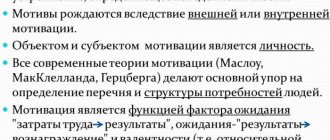The article examines the theories of motivation that have been developed by scientists and examines each of them. There are a couple of approaches when studying motivational theories:
- Substantive - explores the actual essence of theories that study human needs, and those, in turn, become the main motives of our studies. Proponents of this approach include Herzberg, Maslow, McClelland;
- Procedural – based on procedural concepts. Certain behavior is considered, as well as the division of efforts of workers - workers. Its supporters include Porter-Lawler and Vroom.
Basic theories of motivation: in these works, experts try to figure out what exactly motivates society to act. The structure and essence of what people need, as well as the connection of this with the motivation to action, are described. Let's understand these teachings.
Maslow's gradation of needs
We feel different needs for something, which interact and influence each other, first at a lower level, then at a higher level. Needs are combined into groups, representing what an individual needs:
- sleep, food and rest - satisfy the basis of the creature’s life;
- stability and security;
- sociality – the need to communicate with others and loved ones;
- achieving certain goals and objectives;
- universal recognition of one's merits.
So, we have looked at all the steps of Maslow’s pyramid, placed in hierarchical order. Remember, without satisfying what we need, it will not be possible to move from a lower level to the implementation of high and sophisticated requests.
K. Alderfer's theory
After Maslow's theory of needs, K. Alderfer's theory is quite popular and accessible. The founder of the theory believes that any needs can be identified into certain groups. He believes that there are only three groups of needs.
- Existence needs.
- Communication needs.
- Growth needs.
Again, all three of these need groups correlate with Maslow's theory.
Physiological needs and safety needs can be brought closer to the needs of existence
To the needs of communication (belonging and involvement in a social group, family, team).
Growth needs are similar to the self-expression needs of Maslow’s pyramid and also include those needs of the recognition and self-affirmation group that are associated with the desire to develop confidence, self-improvement, etc.
What, then, is the difference between Maslow’s theory and K. Alderfer’s theory?
A. Maslow believes that movement according to needs occurs from the bottom up. From the satisfaction of the lower to the higher.
K. Alderfer believes that the movement occurs in both directions.
- Moving upward is about satisfying needs.
- Downward movement is frustration.
Why is this theory relevant? It is quite popular among managers who are looking for effective forms of motivating their employees and correlating the needs of lower forms if there is no way to satisfy higher ones.
Alderfer's ERG Approach
Like Maslow, this psychologist combined needs, but into different groups: the need for sustenance (human existence), connection and self-improvement, or development (growth). Here, the satisfaction of interests is of a dual nature - first low, then high. But if it is not possible to fulfill some interest, satisfaction goes in the opposite direction - to a lower stage. This phenomenon is called frustration - that is, the opposite direction.
This so-called leadership theory can be usefully applied to the employees of a company. For example, when it is not possible to motivate an employee using high-level needs, they look for ways to motivate at a lower stage.
Every person has motives:
- Individual;
- Due to the characteristics of his personality;
- The existing system of value orientations;
- Social environment;
- Emerging situations, etc., then the path.
Read »Instrumental motivation is the key to success. 10 ways to force yourself to do something."
For this reason, the satisfaction of needs is different.
Motivation determines the choice:
- Between different possible actions,
- Regulating,
- Directing action to achieve target states specific to a given motive
- Supporting this focus.
- Purposeful action.
First, there is a process of weighing the possible outcomes of an action and assessing their consequences.
Despite the fact that the activity is motivated, i.e. aimed at achieving the goal of the motive, it should not be confused with motivation.
The activity consists of the following components:
- skills,
- skills,
- knowledge.
How and in what direction various functional abilities will be used depends on motivation.
The motivation explains the choice:
- between different possible actions;
- different perception options;
- possible ways of thinking;
- intensity and persistence in carrying out the chosen action;
- achieving its results; Let's consider substantive theories of motivation.
McClelland's acquired needs
The main idea of the method is that one should not be distracted by lower-level interests that have already been satisfied, but should pay attention to high-level needs acquired through life experience. There are three such needs - the need for achievement, participation and power:
- The desire to work much more efficiently than before. Such people take full responsibility and also rely only on themselves. They are very persistent, stubborn and strong-willed;
- The need for participation presupposes the need to communicate with people, the willingness to always listen to them. Such a person will not care what they say about him in society. Therefore, the main success is a high social position and positive opinion;
- The desire to rule is the willingness to take control of everything that happens around, all processes and phenomena. This is a “double-edged sword”: either constant and strict control over everything, or unwillingness to take responsibility and avoid any authority.
So, it is difficult to combine these needs into separate groups or indicate the direction of their satisfaction. However, knowledge of these will help in organizing the work of company employees. It is also important to consider how these motivational needs interact and influence each other. Remember that they are not mutually exclusive.
Maslow's theory of motivation in brief and pyramid of needs
All human needs are based on physiological ones - those that are directly related to survival: food, water, air, sex, etc.
At the second level is the need for security and confidence in the future. Here we are talking about the fact that a person seeks protection from the dangers of the external environment.
At the next level of the pyramid are social needs (involvement). These are people’s feelings that arise in relation to the social whole: the environment, close people who would support it.
Further, on the fourth hierarchical link are the needs for respect and social recognition. People want to be valued, praised for their achievements, competence, and respected by people in authority.
The highest level is the need for self-expression and self-realization. It is necessary for a person to realize his personal potential.
Porter-Lowler model
Porter and Lauler created a method that incorporates elements of expectancy theory and equity theory. The developed model consists of the following points:
- effort made;
- perception;
- results achieved;
- reward;
- feeling of satisfaction.
According to the theory, the results directly depend on our qualities, efforts, and abilities, therefore, to determine the motivation of employees, it is enough to take them into account. High performance is achieved when work done is rewarded (material incentives). It follows that achieving good results becomes the reason for quality work. The cause, but not the effect.
Victor Vroom's Expectancy Theory
An equally interesting concept was proposed by V. Vroom. The main idea within this model is that the behavior of a company employee is influenced by 2 factors.
The main thesis is as follows: the motivation of an employee is influenced by how realistic it is to achieve the goal set for him, and how much this task is generally desirable and appropriate.
A person asks himself two questions:
— will the efforts made ensure a high level of performance of work assignments?
— will effective activities lead to the desired results?
How likely is it that the efforts made will lead to a result that meets the expectations of the authorities. And will he receive a decent reward in return for good work, for example, a material bonus?
Hedonic motivational method
His supporter Jung found that people want to achieve maximum joy and minimum discomfort. Enjoyment is a fundamental factor that determines the active desire to work, the direction and organization of actions. Emotions drive behavior. If they are positive, the action is repeated, otherwise not.
Proponents of this method argue that emotions appear to be pleasure to some level that can be determined. After satiety comes the complete opposite - displeasure. In this method, two necessary factors are distinguished: the level of stimulation and hedonic tone, subjective pleasure depends on the latter.
Performance Needs
The need for achievement is expressed in a person's desire to achieve his goals more effectively than in the past. People with a high need for achievement prefer to set their own goals. They usually choose moderately challenging goals and objectives based on what they can achieve and what they can do. People with a high need for achievement tend to make moderately risky decisions and expect immediate feedback on their actions and decisions. They enjoy making decisions and taking responsibility for completing a task, they are obsessed with the tasks they complete and easily accept personal responsibility.
Based on the above characteristics, it can be said that members of an organization with a high need for achievement are willing to accept work that contains elements of challenge, which allows them to set goals independently. However, it is very difficult for them to engage in work that does not produce clear and tangible results quickly enough. They can be enthusiastic and constantly busy, but at the same time they need to constantly achieve results. It is important to note that the quality of the result, like the quality of their work, is not necessarily the highest. People with this need work hard and love to work, but do not like to share work with others. They are much less satisfied with the result achieved together than if they achieved this result alone.
Based on his research, McClelland came to the conclusion that this need is determined not only by the characteristics of individual people, but also by the characteristics of individual societies. Societies with a high need for achievement usually have well-developed economies. Conversely, in societies with a low need for achievement, the economy develops slowly or does not develop at all.
High need for achievement is believed to influence employee commitment and performance. Therefore, it is useful to assess the level of performance needs of organizational members during their promotions, as well as of candidates for joining the organization. Performance needs assessment can also be used to match the nature and content of the job to performance needs.
To cope with the magnitude of this need, it is important to train members of the organization and organize work accordingly. In particular, it is advisable to include regular feedback and examples of successful achievement of goals. Since people with a high need for achievement also have high self-esteem and therefore are not inclined to set difficult goals for themselves, it is necessary to try to correct their self-esteem.
The drive to achieve is what makes people successful in solving the problems they face. A successful entrepreneur must have a high level of need for achievement. However, often people with a high need for achievement do not reach the highest levels of the leadership hierarchy because the upper levels of leadership require taking more risky decisions and setting higher goals, which people with a high need for achievement are not ready for. Therefore, it is quite obvious that for people engaged in self-employment, it is desirable to have a high need for achievement. When a person works in a large organization, a high need for achievement can create many problems for him and his colleagues around him.
The need for empathy manifests itself as a desire to communicate with other people. People with a high need for empathy strive to build and maintain good relationships, seek recognition and support from others, and are concerned about what others think of them. It is very important to them that someone needs them, that their friends and colleagues care about them and what they do.
People with a high need for affiliation prefer positions and jobs that allow them to actively interact with people, both colleagues and clients. For such team members to be successful, they need to create an environment that allows them to regularly receive information about how others react to their actions and provides them with the opportunity to actively interact with a large enough group of people. Management must regularly assess the extent of this need among its subordinates in order to promptly make appropriate adjustments to the organization of work as the degree of overall responsibility of individual employees changes. Of course, an analysis of the degree of need for participation should also be carried out when hiring a person to work in an organization.
The need for power is the third basic need, the influence of which on human behavior was studied and described by McClelland. This need, like the previous two, is acquired, develops on the basis of learning, life experience and consists in a person’s desire to control the resources and processes occurring in his environment. The main focus of this need is the desire to control people’s actions, influence their behavior, and take responsibility for the actions and behavior of other people. The need for power has two poles: the desire to have as much power as possible, to control everything and everyone, and, on the contrary, the desire to completely abandon any claims to power, the desire to completely avoid such situations and actions that are associated with the need to perform the functions of power.
People with high motivation for power can be divided into two, in principle, mutually exclusive groups. The first group consists of those who seek power for power's sake. First, they are attracted to the opportunity to command others. For them, the interests of the organization often fade into the background and even lose their significance, since they focus on their leadership position in the organization, their ability to dominate, and their power in the organization.
The second group includes those people who strive for power to achieve group goals. These people satisfy their need for power by defining goals, setting goals for the team, and participating in the process of achieving goals. It is very important to note that they look for ways to motivate people to achieve these goals and collaborate with the team in both setting goals and achieving them. That is, for these people, the need for power is not a desire for pretentious self-affirmation to satisfy their vanity, but a desire for responsible leadership in the context of solving organizational problems, which, by the way, is also a desire for pretentious self-affirmation.
Psychoanalytic motivational method
Freud created and developed the psychodynamic approach to the study of human behavior. It is based on the recognition that there are psychological forces that shape our actions, but are not always conscious of them. Freud believed that instincts drive our behavior. Eros is life. Thanatos – destruction and death. Source, goal, object and stimulus are the main instinctive parameters. An individual is understood as a community of three parts:
- “I” – knowledge of oneself and one’s “ego”;
- “Id” (it) – accumulates instincts and impulses;
- “Superego” (unconscious) – moral behavioral aspects.
Drive Theory
The author of the “drives” method is Karl Hull. All changes within a person lead to some kind of reaction, a change in activity. Thus, the personality tries to eliminate any changes. The components of such elimination are “drives” (i.e. “attractions”). This behavior is reinforced by repeated attempts, which strengthen the reaction, since the behavior confirmed by something is reliably fixed in the person’s mind.
In economically developed countries, employee activity is supported by remuneration. But you need to be careful with this: such a person may not do anything else if there is no new confirmation (encouragement).
Classification and characteristics of modern theories of motivationCurrently, there are 3 main groups of theories of motivation:
• initial
,
• substantive
,
• procedural
.
ORIGINAL THEORIES OF MOTIVATION
Initial theories of motivation are based on the use of simple coercive incentives and material and moral incentives for workers.
The theory of “carrots” and “sticks” (positive and negative motivation) is widely known, according to which employees clearly know what they can be rewarded for and what they can be punished for.
The development of the theory of “carrot” and “stick” is the theory of “X” and “Y” by D. McGregor. This theory includes two opposing concepts (see Table 1).
Table 1. Theory of motivation by D. McGregor
“X”
| "Y" | |
| • Biological needs predominate in motives; • A person does not like to work, so labor must be rationed, and people must be forced to work; • The person prefers to work to be controlled, tries not to take responsibility, has relatively low ambitions and wants to be in a safe situation; • The quality of work is low, so constant strict control is required. | • The motives are dominated by social needs and the desire to work well; • For a person, work can be a source of pleasure, or it can be a punishment, depending on the conditions; • Usually a person is ready to take responsibility; • Many people are willing to use their knowledge and experience in their work; • External contacts and the threat of punishment are not the main incentives; • The most important rewards come from satisfying self-expression needs. |
| Main incentive: • coercion. Auxiliary stimulus: • financial incentives | Main incentives: • self-affirmation; • moral and material encouragement. Auxiliary incentives: • coercion. |
According to the theory of “X” and “Y”, when motivating employees, it is necessary to take into account the state of their level of consciousness. Managers should strive to develop a group, if it is not sufficiently motivated, from state "X" to state "Y".
Theory “Y” was developed in the works of W. Siegert and L. Lang, who noted the importance of awareness, freedom of action and the significance of the employee’s workplace for motivating his work activity.
The theory of “X” and “Y” was further developed in the works of V. Ouchi, who substantiated the importance of the team in motivation. The main provisions of the “Z” theory of motivation by V. Ouchi are the provisions on the combination of social and biological needs in the motives of employees and their preference to work in a group and apply the group decision-making method.
Thus, a good employee prefers to work in a group and have stable performance goals for the long term.
Workers described by theories “X”, “Y” and “Z” form different groups of people and prefer different motives of behavior and incentives to work. As a rule, all types of people are represented in an enterprise, and the application of one or another motivation concept is determined by the proportion of workers of a particular type in the group.
SUBSTANTIVE THEORIES OF MOTIVATION
Content theories of motivation are based on the identification of needs that cause people to act in a certain way. The most famous are the theories of A. Maslow, K. Alderfer, D. McClelland, F. Herzberg. Each of the authors offers its own classification of needs that have the greatest impact on a person’s work activity. According to substantive theories, management of work motivation consists of identifying a person’s dominant need and developing measures to satisfy it (see Fig. 1).
Rice. 1.
A. Maslow's hierarchy of needs theory
According to this theory, human behavior is determined by needs, which can be divided into five groups and arranged in a strictly hierarchical structure (see Fig. 2).
Rice. 2. Motivational model of A. Maslow
According to A. Maslow’s definition, a person is an “eternally wanting creature”: when a lower need is satisfied, a higher one becomes dominant. Consequently, in terms of the power of influence on the employee’s behavior, the dominant needs will be those located directly above only satisfied needs.
However, as practice shows, hierarchical levels are not discrete steps. People tend to start looking for their place in the community long before their safety needs are met or their physiological needs are fully satisfied.
K. Alderfer's theory
Clayton Alderfer combined human needs into three groups: 1. Existence needs; 2. Communication needs; 3. Growth needs.
The needs groups of this theory correlate with the needs groups of A. Maslow’s theory. Existence needs include safety needs and physiological needs; group of communication needs - belonging and involvement; growth needs - needs of self-expression.
However, in contrast to the theory of A. Maslow, K. Alderfer believes that the movement goes in both directions: upward, if the need of the lower level is not satisfied, and downward, if the need of the higher level is not satisfied.
K. Alderfer calls the process of moving up the levels of needs the process of satisfying needs, and the process of moving down the process of frustration, i.e. defeat in the effort to satisfy the need (see Fig. 3).
Rice. 3. Scheme of ascent and reversal of K. Alderfer’s hierarchy of needs
D. McClelland's theory of needs
D. McClelland identifies three needs that have the greatest impact on an employee’s performance: power, success, involvement (see Table 2).
Table 2. D. McClelland's theory of needs
| Needs | a brief description of | Motivation management | |
| 1. | Complicity | Striving for friendly relations and active interaction with colleagues and clients. | Providing work with broad communication capabilities and constantly informing about the reactions of others to their actions. |
| 2. | Achievements | The desire for independence in work, personal responsibility for the results obtained. | Delegation of authority, independent area of work. |
| 3. | Rule | The desire to influence other people, control resources and processes. | Inclusion in the personnel reserve, career planning, training. |
The needs of participation, achievement and power in the concept of D. McClelland are not mutually exclusive: the manifestation of the influence of these needs on human behavior strongly depends on their mutual influence.
F. Herzberg's theory of motivation
In the literature, F. Herzberg’s theory of motivation is often called the theory of motivational hygiene or the theory of “social man.”
F. Herzberg identified two groups of incentives for intensifying a person’s work activity: hygienic, motivational (see Table 3).
Hygiene motives are motives that create the mood for work; they can be both motivators and demotivators of work activity.
The manager's goal is to create conditions so that hygiene factors become motivators of work activity. F. Herzberg considers motivating factors to be those that always contribute to increasing the efficiency of workers.
Table 3. F. Herzberg's model
Hygiene factors | Motivating factors (motivators) |
| • Salary; • Social benefits; • Working conditions; • Status; • Climate at the enterprise; • Working atmosphere, environment; • Attitude towards superiors and colleagues. | • Interesting work: exciting questions, versatility, opportunity to improve your knowledge; • Independence and authority, your own area of work; • Opportunity to achieve tangible results; • Recognition of achievements, expressed in increased income, powers, degree of difficulty of assigned tasks; • Professional training and advanced training as a continuous process. |
Consequently, if we eliminate the factors of employee dissatisfaction with the work environment, then it is possible to form the motives of his work activity using factors of job satisfaction.
Table 4 shows the basic principles of enriching the content of work to motivate work activity.
Table 4. Principles for enriching the content of work according to F. Herzberg
| Principle | Motivation Factors Involved |
| 1. Eliminate some controls while maintaining responsibility. | Responsibility and sense of achievement. |
| 2. Increase employee responsibility for the results of their work. | Responsibility and recognition. |
| 3. Allocate the employee a complete block of work (part, department, etc.). | Responsibility, sense of achievement and recognition. |
| 4. Give the employee additional authority. | Responsibility, sense of achievement and recognition. |
| 5. Periodically consult with the employee himself, and not with his immediate superior. | Internal recognition, self-esteem. |
| 6. Offer the employee new, increasingly difficult tasks. | Professional growth and training. |
| 7. Assign employees tasks that require special knowledge and skills. | Responsibility, professional growth and training. |
The groups of needs proposed by different authors of substantive theories are quite clearly correlated with each other (see Fig. 4).
Rice. 4.
PROCESS THEORIES OF MOTIVATION
Process theories of motivation are based on the assumption that an individual's behavior is a function of his perceptions and expectations associated with a particular situation and the possible consequences of his chosen type of behavior.
Three main procedural theories can be distinguished: 1. Expectancy theory; 2. Theory of justice; 3. Reinforcement theory.
V. Vroom's expectancy theory
It is based on the principle that the more an employee’s expectations are met, the more effective his work will be. V. Vroom identifies 3 main expectations of an employee in the labor process: that his labor efforts bring concrete results, according to which he will receive the expected reward (see Fig. 5).
Rice. 5. V. Vroom’s model of motivation
Valence is the perceived degree of relative satisfaction (dissatisfaction) that occurs when receiving a reward. If there is no direct connection between the effort expended and the results achieved, then motivation will weaken.
S. Adams' theory of justice
According to equity theory, people subjectively determine the ratio of reward received to effort expended, and then relate it to the rewards of other people doing similar work.
If a comparison shows that a colleague received more compensation for the same work, then the employee experiences psychological stress; to restore justice, it is necessary to either change the level of effort expended or change the reward.
Experts note that usually when people believe that they are not being paid extra, they begin to work less intensively. If they feel they are overpaid, they are less likely to change their behavior and activities.
B. Skinner's theory of motivation enhancement
Shows the dependence of employee motivation on their past experience.
According to B. Skinner's theory, the presence of stimuli causes a certain behavior in a person, depending on the consequences of which it is repeated or not. Repeated repetitions of the same results lead to the formation of a certain behavioral attitude in a person.
Porter-Lawler model
L. Porter and E. Lawler combined elements of expectancy theory and justice theory in their theory of motivation (see Figure 6).
Rice. 6. Porter-Lawler integrative model
According to the model, the results achieved depend on the efforts made, the abilities and characteristics of a person, as well as on his awareness of his role in the labor process. The level of effort expended in turn depends on the value of the reward and the extent to which the person believes that there is a strong connection between the effort expended and the possible reward. Achieving the required level of performance may entail internal rewards (satisfaction from the work performed, a sense of competence and self-esteem) and external rewards (supervisor praise, bonus, promotion).
Satisfaction is the result of external and internal rewards, taking into account their fairness. Without satisfaction there can be no effective work.
D. Atkinson's theory of work motivation
It is based on the position that an employee’s behavior is the result of the interaction of individual qualities of a person and the situation, its perception. Every person has two motives - the motive of success ( Mu
) and the motive to avoid failures (
Mn
). These motives are quite stable and are formed in the process of learning and work; they manifest a person’s desire for a certain level of need satisfaction.
In addition to personal qualities, a person’s behavior is influenced by 2 situational variables: the probability of success with which the employee expects the completion of his activity ( Wu
) and the attractiveness of success (stimulus value) for the individual (
Pu
). Moreover, the attractiveness of success is directly related to the probability of success according to formula 1:
Formula 1.
Pu = 1 – Wu
(1)
Thus, the higher the probability of success, the lower its attractiveness.
The desire for success ( Su
), which expresses the strength of motivation, can be expressed by formula 2:
Formula 2.
Su = Mu
*
Woo
*
Poo
(2)
According to this formula, the desire for success will be maximum when the probability of success is 0.5, because Wu's work
*
Pu
in this case is maximum. But when determining the desire for success, it is necessary to take into account the motive for success, which is expressed differently among different employees.
Any specific situation activates the motive for success and at the same time the motive that encourages you to avoid failures .
.
In this case, the sum of the probability of expecting success Wu
and the probability of failure
Bn
is equal to 1.
According to D. Atkinson's theory, people who are more success-oriented prefer tasks of average complexity, because in this case, the degree of risk is lower, although the attractiveness of success is less. At the same time, employees who accept failure for the sake of the high attractiveness of possible achievement of the goal prefer extreme tasks on the principle of “do or die”; such employees belong to the so-called “risky” personality type. It is advisable to entrust the first group of employees with those tasks that absolutely must be completed within the allotted time frame, while the second group of employees is best used when it is necessary to find atypical solutions.
Thus, procedural theories of motivation are aimed at developing such an employee’s work behavior that will ensure the effectiveness of his work activity. Process theories of motivation are more universal compared to substantive theories of motivation, but, unfortunately, do not take into account the entire range of human needs.
Free consultation: +7 (499) 938-42-57
McGregor's "X" and "Y" methods
McGregor called theory “X” the expectation of anti-democratic failure from subordinates, and theory “Y” the assumptions about the employees of a liberal-minded boss. These theories address the different desires and motivations of people. The area of motivation is very changeable and dependent on various circumstances: some motives become stable, subordinate other motives and are the foundation of the entire area.
Differences in behavior in similar situations and under similar circumstances are determined by the fact that each person has his own measure of perseverance and internal energy. Some people diversify their actions when reacting to a situation, while others behave monotonously. Sometimes actions are not able to fully satisfy the motive. In this case, a person completes one type of work and begins another. The motive can also change during the activity, for example, you wanted to draw with pencils, but then you got tired of this activity. Sometimes the type of work changes, but the motive remains the same, for example, a person who was initially carried away by watercolors later began to paint in oils.
It happens that motivation goes ahead of activity or lags behind it. Motives set alternatives for various actions that regulate and correct activity to approach the characteristic target characteristics of a specific motivation, and also support such orientation. Only motivation becomes the reason for purposeful activity.
Motivation does not become a continuous and indivisible process. It consists of procedures of various kinds that regulate behavior before and after actions. First comes the analysis process: the consequences of possible work results are assessed. The purpose of actions is the embodiment of motive, but still they should not be confused with motivation. Actions add up erudition, abilities and skills. Motivation is determined by how different opportunities will be used. Motivations determine the selection of specific actions, approaches to perception and all kinds of ways of thinking, as well as tension and persistence in implementing a specific action and achieving its results.
So, we have looked at the main motivational theories in psychology. If you put them into practice, you will be able to properly organize your employees and achieve progressive results.
Basic theories of motivation
Agree, it would be great to have a “want/don’t want” switch. But alas, he is gone. You want something not just because you decide to. You may decide to learn something new, break a bad habit, or radically change your life. But that doesn't mean you'll do it, right? Somehow, on New Year’s Eve, I decided that I would blog regularly, calculated the time, outlined a plan, and even wrote about it in an article. But something went wrong again. I don't have such a switch either.
Motivation theories in psychology are ways to understand why you are motivated to do certain things. Experienced managers and, perhaps, your manager use them when working with personnel. They are trying to figure out what you need to make you work harder. That is, they try to calculate your desires and needs, find control levers and motivate you more to work. Great, if there is such a tool, you can use it for your own purposes!
There are 2 types of motivation theories:
- meaningful - your actions are determined by your needs;
- procedural—study the factors that make you exert effort.
Below we will look at 4 main theories of motivation (2 of each type) and how to apply them in life. And the squirrel from the cartoon “Ice Age” will help us with this. If you don't know, he is a minor character who is constantly chasing a nut. No matter what happens in the plot, the squirrel has “its own war.” What motivates her? Let's figure it out now.
Ready? Then let's go in order!








